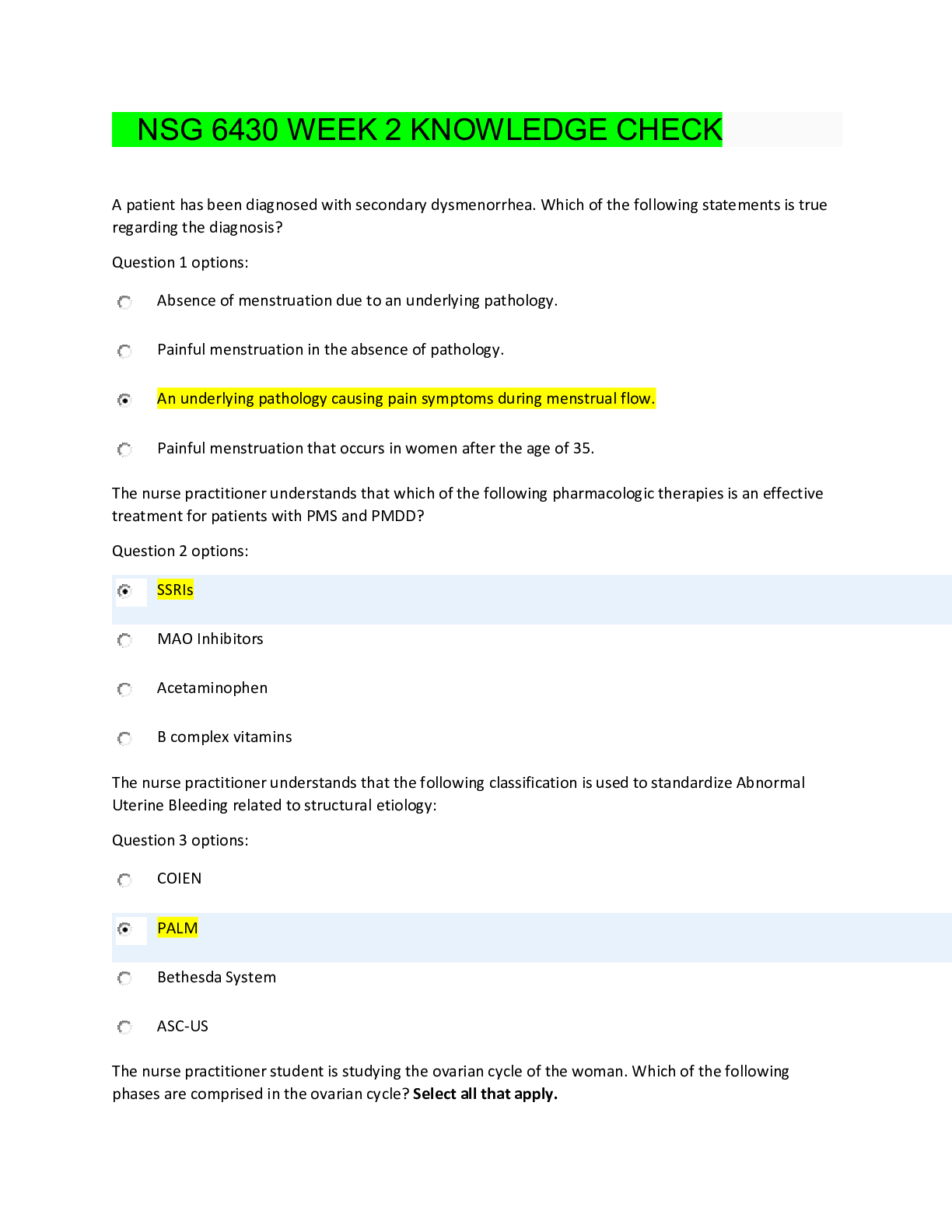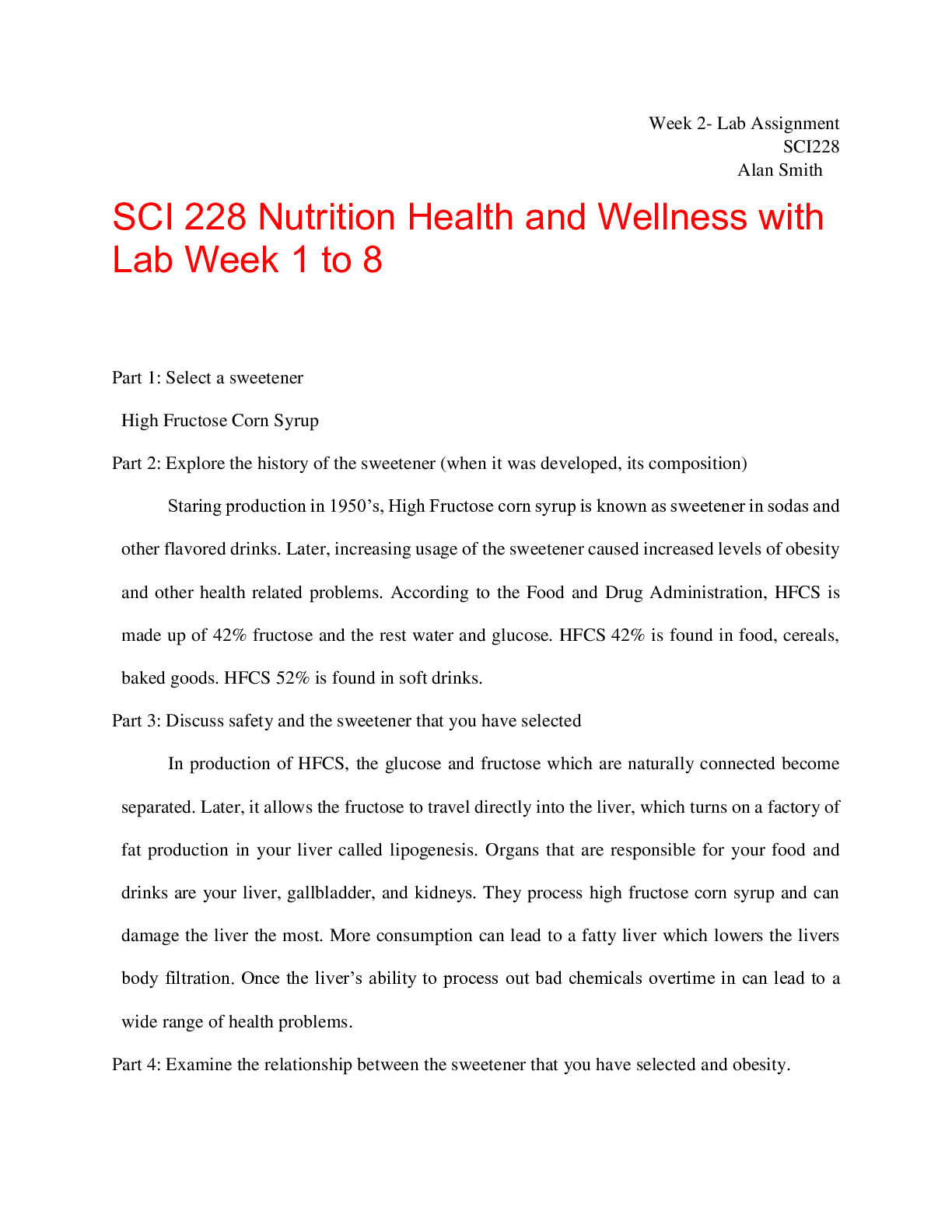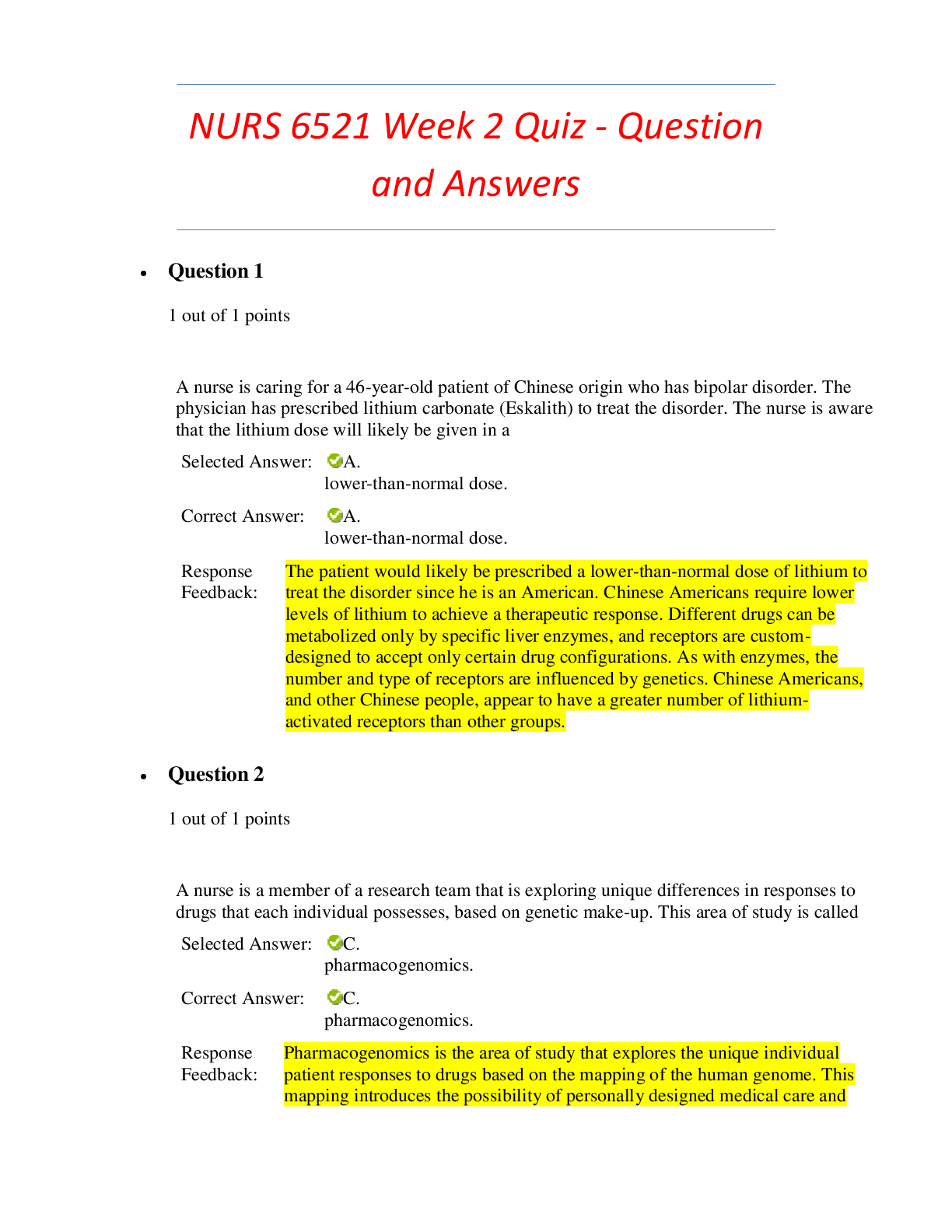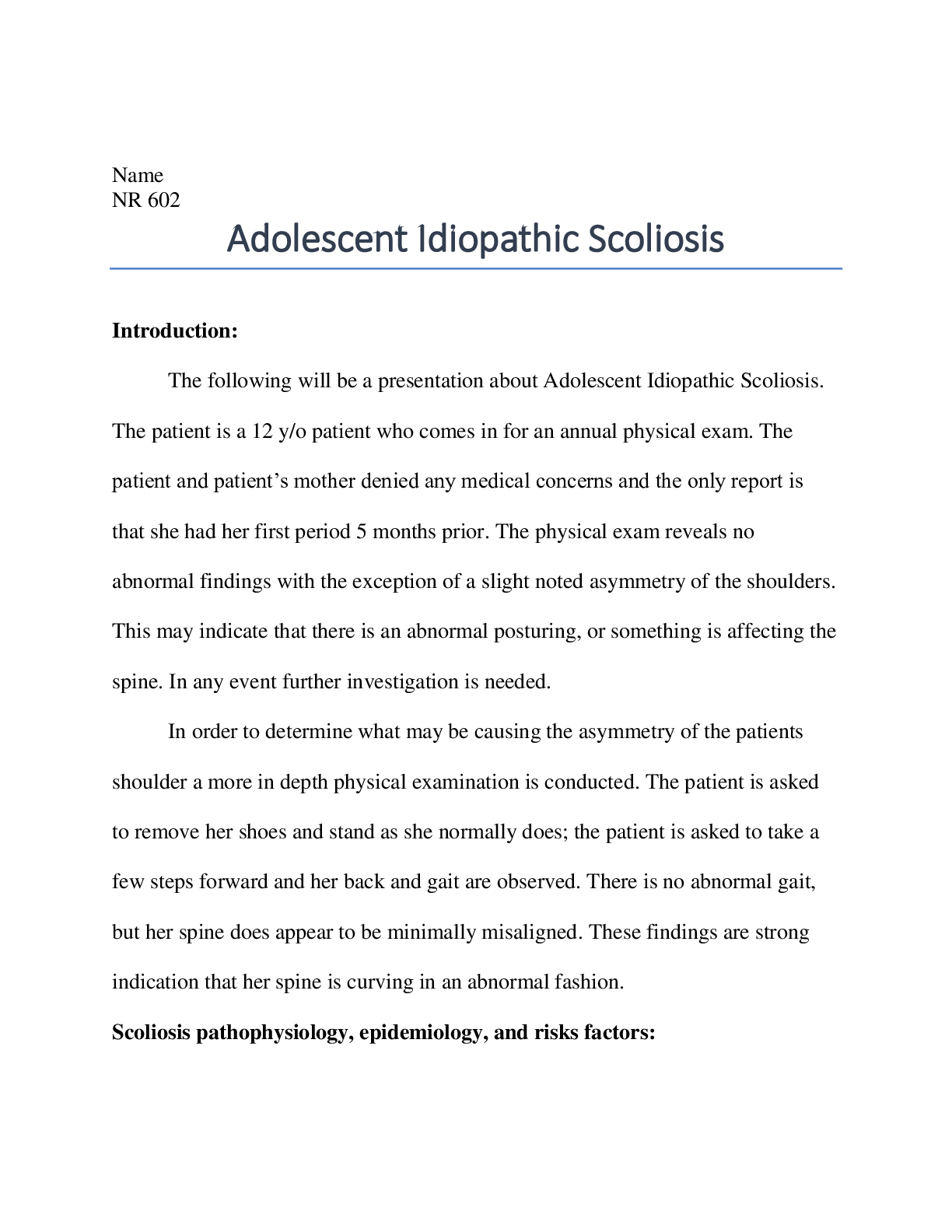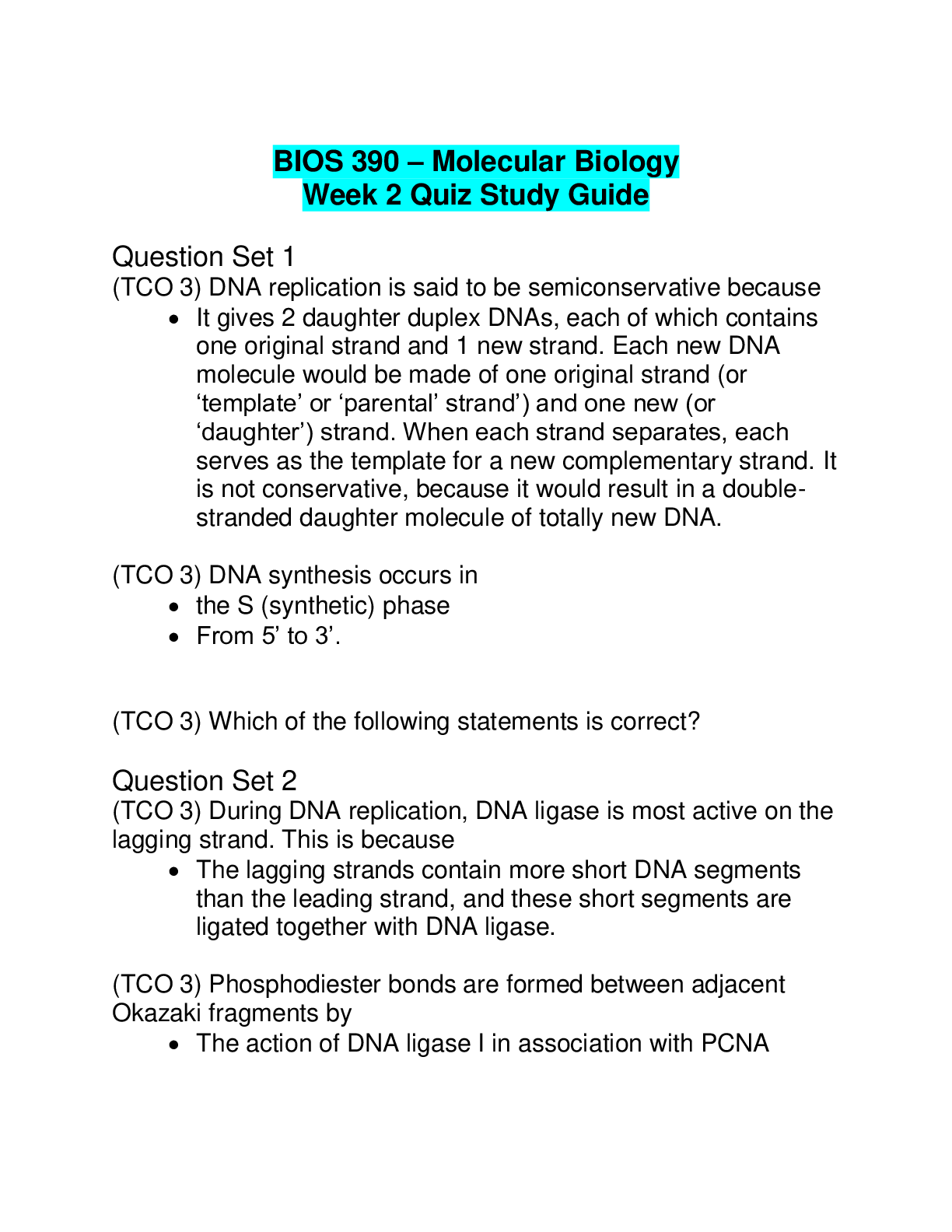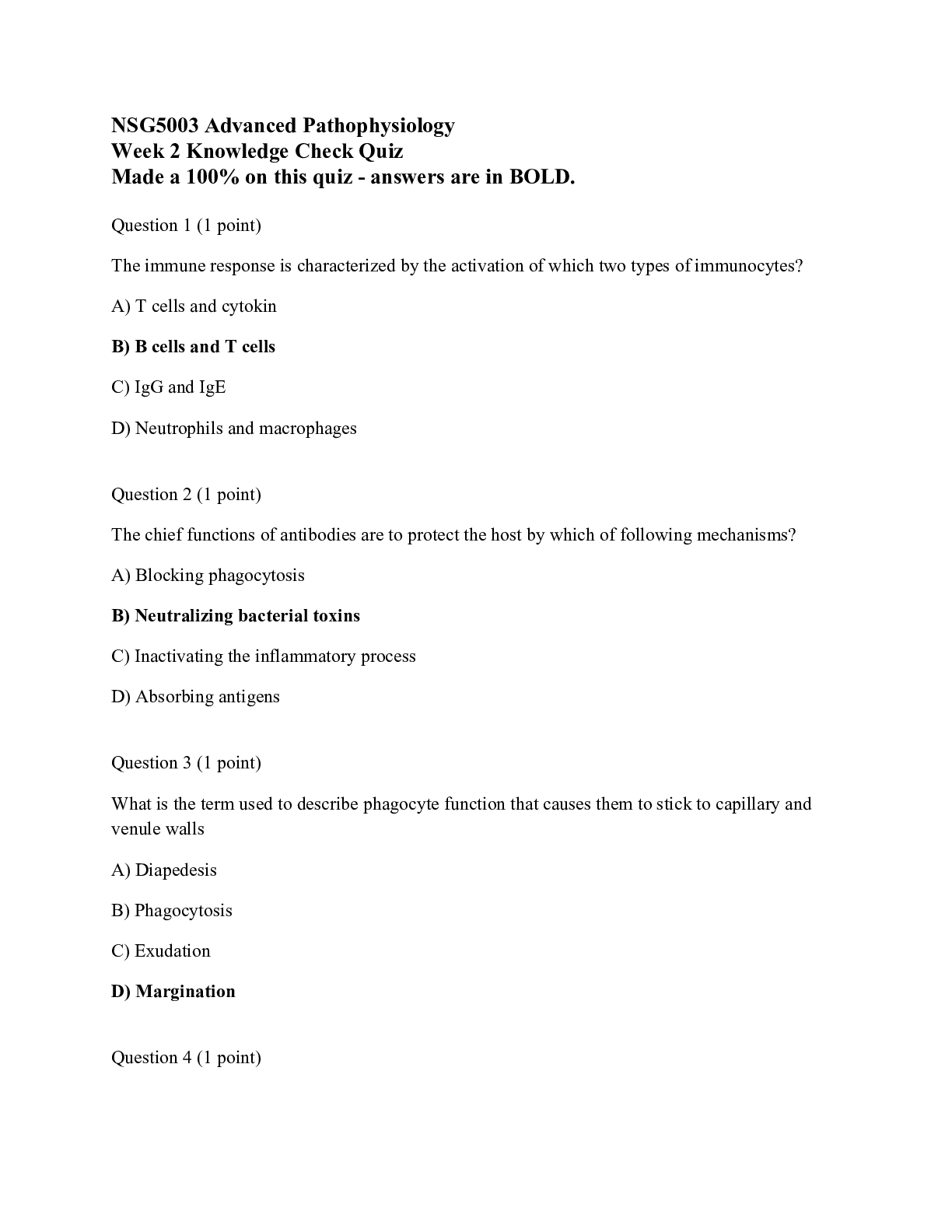*NURSING > QUESTIONS & ANSWERS > Dakota Wesleyan University - MATERNAL H 300: ATI Exam Week 2 Practice Questions. ATI Week 2 Practic (All)
Dakota Wesleyan University - MATERNAL H 300: ATI Exam Week 2 Practice Questions. ATI Week 2 Practice Questions Study Materials: MATERNAL H 300.
Document Content and Description Below
MATERNAL H 300. ATI Week 2 Practice Questions 1) A nurse is caring for a client who is breastfeeding and states that her nipples are sore. Which of the following interventions should the nurse sugge... st? a) apply mineral oil to the nipples between feedings b) keep the nipples covered between breastfeeding sessions c) change the newborn’s position on the nipples with each feeding d) increase the length of time between feedings 2) A nurse is caring for a client who is 4 hr postpartum following a vaginal birth. The client has saturated ka perineal pad within 10 min. Which of the following actions should the nurse take first? a) massage the client’s fundus b) assess the bladder for distention c) prepare to administer a prescribed oxytocic preparation d) Assess client’s blood pressure 3) A nurse on the obstetric unit is caring for a client who experienced abruptio placentae. The nurse observes petechiae and bleeding around the IV access site. The nurse should recognize that this client is at risk for which of the following complications? a) preeclampsia b) disseminated intravascular coagulation c) anaphylactoid syndrome of pregnancy d) puerperal infection 4) A nurse in a prenatal clinic is teaching a group of clients about nutrition requirements during lactation. Which of the following statements should the nurse make? a) zinc intake should be at least 12 mg per day b) calcium intake should be at least 2,000 mg per day c) the recommended intake of iron increases d) the recommended intake of folic acid remains the same as for pregnant women 5) A nurse in the newborn nursery is caring for a group of newborns. Which of the following newborns requires immediate intervention? a) a newborn who is 18hr post-delivery and has acrocyanosis b) a newborn who is 24hr post-delivery and has not voided c) a newborn who is 12hr post-delivery and has a temperature of 37.5C(99.5F) d) a newborn who is 24hr post delivery and has not passed meconium 6) A nurse observes that a newborn has a pink trunk and head, bluish hands and feet, and flexed extremities 5 min after delivery. He has a weak and slow cry, a heart rate of 130/min, and cries in response to suctioning. The nurse should document what Apgar score for this infant? **Apgar scoring is an assessment of five areas of newborn well-being: respiratory effort, heart rate, muscle tone, reflex irritability and color. This newborn scores 2 each for heart rate, muscle tone and reflex irritability. The weak cry and acrocyanosis of the hands and feet score 1 each, for a total of 8 7) A nurse is caring for a client during a nonstress test (NST). At the end of a 30-min period of observation the nurse notes the following findings: The fetal heart rate baseline is 120/min with minimal variability and no accelerations. There are two decelerations of 15/min in the fetal heart rate during a period of fetal movement, each lasting 20 seconds. Which of the following interpretations of these findings should the nurse make? a) a reactive test b) a negative test c) a positive test d) a nonreactive test 8) A nurse is caring for a newborn delivered by vaginal birth with a vacuum assist. The newborn’s mother asks about the swollen area on her son’s head. After palpation to identify that the swelling crosses the suture line, which of the following is an appropriate response by the nurse? a) Mongolian spots can be found on the skin of many newborns b) this is erythema toxicum, which is a transient condition c) a caput succedaneum occurs due to compression of blood vessels d) this is a cephalohematoma, which can occur spontaneously 9) A nurse is caring for a client who is scheduled for a cesarean birth based upon the fetal lungs having reached maturity. Which of the following findings indicates that the fetal lungs are mature? a) phophatidylglycerol (PG) absent b) nonstress test is reactive c) biophysical profile score of 8 d) lecithin/sphingomyelin (L/S) ratio of 2:1 10) A nurse on a postpartum unit is giving discharge instructions to a client whose newborn had a circumcision with the Plastibell technique. Which of the following client statements indicates understanding of circumcision care? (Select all that apply) a) I’ll expect the plastic ring to fall off by itself within a week b) I’ll call the doctor if I see any bleeding c) I’ll apply petroleum jelly to his penis with diaper changes d) I’ll wash his penis with warm water and mild soap each day e) I’ll make sure his diaper is loose in the front 11) A nurse is caring for a newborn and calculating the Apgar score. At 1 min after delivery, the following findings are noted: heart rate of 110/min; slow, weak cry; some flexion of extremities; grimace in response to suctioning of the nares; body pink in color with blue extremities. Calculate the newborn’s Apgar score. 6 the apgar scores is 6 out of a possible 10, it is based on 5 signs evaluated at 1 and 5 min after delivery that indicate the physiologic state of the newborn as he transitions from intrauterine life to extrauterine lfe, heart rate over 100/min = 2, slow weak cry =1, some flexion of extremities=1, grimace in response to suctioning of the nares = 1, body pink in color with blue extremities = 1, A score of 4 to 6 indicates moderate difficulty adjusting to life outside of the womb. 12) A nurse is caring for a newborn and assessing newborn reflexes. To elicit the Moro reflex, the nurse should take which of the following actions? a) hold the newborn vertically allowing one foot to touch the table surface b) place a finger at the base of the newborn’s toes c) Perform a sharp hand clap near the infant d) Turn the newborn’s head quickly to one side. 13) A nurse is caring for a client who is 12hr postpartum following a vaginal delivery. Which of the following findings should the nurse expect? a) fundus firm at the level of the umbilicus b) fundus soft, 1 cm to the right of the umbilicus c) fundus present to the left of the umbilicus d) fundus soft, 2cm above the umbilicus 14) A nurse in a provider’s office is caring for a client who is at 36 weeks of gestation and scheduled for an amniocentesis. The client asks why she is having an ultrasound prior to the procedure. Which of the following is an appropriate response by the nurse? a) it is useful for estimating fetal age b) it assists in identifying the location of the placenta and fetus c) this is a screening tool for spina bifida d) this will determine if there is more than one fetus 15) A nurse is assessing a newborn the day after delivery. The nurse notes a raised, bruised area on the left side of the scalp that does not cross the suture line. How should the nurse document this finding? a) cephalohematoma b) molding c) pilonidal dimple d) caput succedaneum 16) A nurse on the labor and delivery unit is caring for a newborn immediately following birth. Which of the following actions by the nurse reduces evaporative heat loss by the newborn? a) placing the newborn on a warm surface b) maintaining ambient room temperature at 24C(75F) c) preventing air drafts d) drying the newborn’s skin thoroughly* 17) A nurse is caring for a client who is 5hr postpartum following a vaginal birth of a newborn weight 9lb 6oz (4252g). The nurse should recognize that this client is at risk for which of the following postpartum complications? a) retained placental fragments b) thrombophlebitis c) uterine atony* d) puerperal infection 18) A nurse is assisting a client who is postpartum with her first breastfeeding experience. When the client asks how much of the nipple she should put into the newborn’s mouth, which of the following responses should the nurse make? a) your baby’s mouth is rather small so she will only take part of the nipple b) you should place your nipple and some of the areola into her mouth* c) babies know instinctively how much of the nipple to take into their mouth d) try to place the nipple, the areola, and some breast tissue beyond the areola into her mouth. 19) A nurse is planning care for a preterm newborn. Which of the following nursing interventions to development should be included in the plan of care? a) use fingertips when calming the newborn b) position the newborn to promote extension of muscles c) keep the newborn in a well-lit nursery d) cluster the newborn’s care activities* 20) A nurse is caring for a client who is postpartum and finds the fundus slightly boggy and displaced to the right. Based on these findings, which of the following actions should the nurse take? a) assist the client to the bathroom to void* b) encourage the client to perform Kegel exercises c) ask the client to rate her pain d) encourage the client to move to the left lateral position 21) A nurse is caring for a client who is postpartum and is breastfeeding. The client states that she is concerned about dietary precautions since she has a family history of food allergies. The nurse offers which of the following responses? a) foods you eat do not affect breast milk b) you might want to avoid eating peanuts* c) rice cereals can be a problem during lactation d) the infant needing more sleep can indicate a food allergy 22) A nurse is teaching a client who is breastfeeding about dietary recommendations. Which of the following statements by the client indicates understanding of the teaching? a) I will decrease my daily fiber intake b) I’ll make sure I reduce salt in my diet c) I’ll eat more protein at each meal* d) I will consume more vitamin D-rich foods 23) A nurse is caring for a client who is 6hr postpartum. The client is Rh-negative and her newborn is Rh-positive. The client asks why an indirect coombs test was ordered by the provider. Which of the following is an appropriate response by the nurse? a) It determines if kernicterus will occur in the newborn b) it detects Rh-positive antibodies in the mothers blood* c) it determines the presence of maternal antibodies in the newborns blood d) it detects Rh-negative antibodies in the newborn’s blood 24) A nurse is admitting a client who is at 36 weeks gestation and has painless, bright red vaginal bleeding. The nurse should recognize this finding as an indication of which of the following conditions? a) precipitous labor b) abruptio placentae c) placenta previa d) threatened abortion 25) A nurse places a newborn under a radiant heat warmer after birth. The purpose of this action is to prevent which of the following in the newborn. a) shivering b) basal metabolic rate reduction c) cold stress* d) brown fat production [Show More]
Last updated: 2 years ago
Preview 1 out of 6 pages
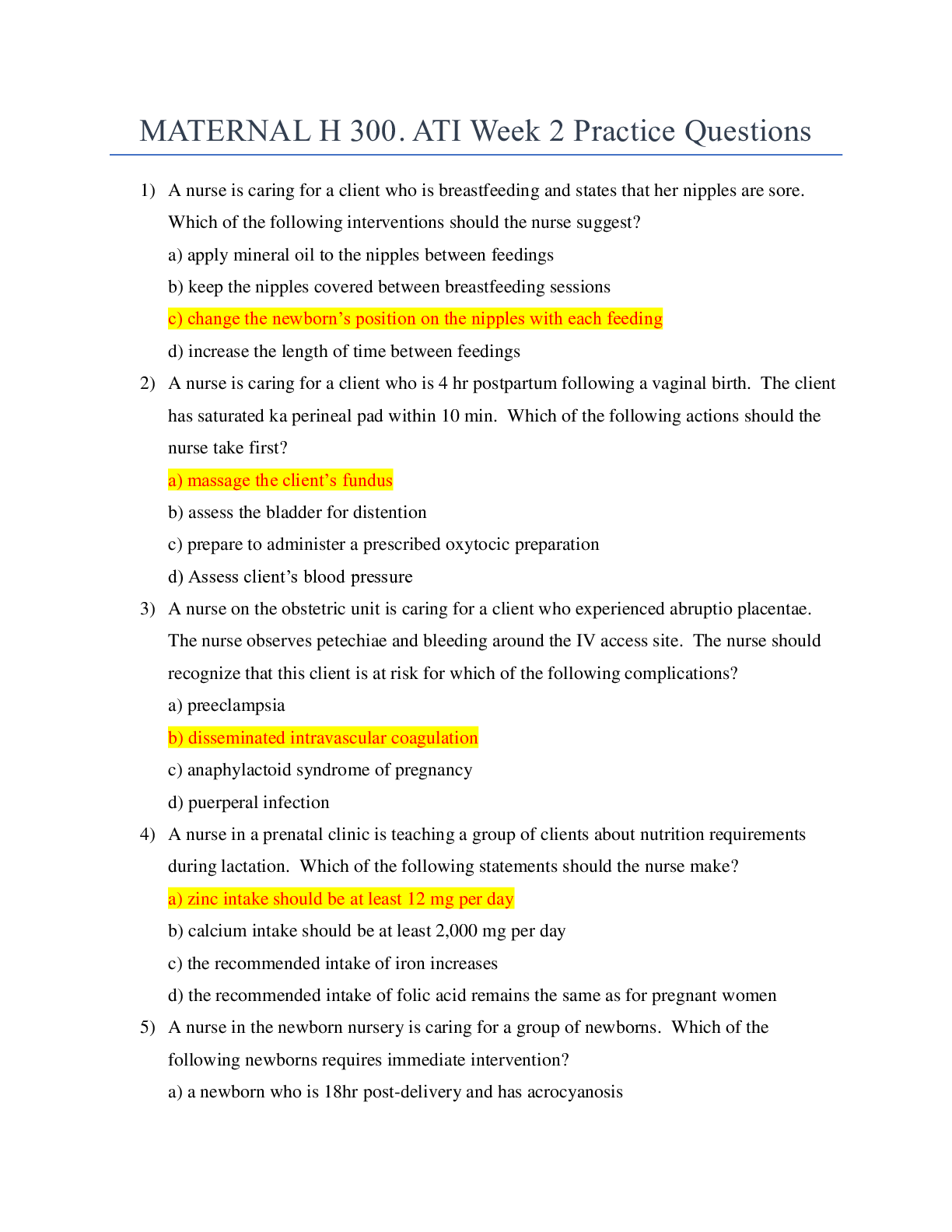
Buy this document to get the full access instantly
Instant Download Access after purchase
Buy NowInstant download
We Accept:

Reviews( 0 )
$11.00
Can't find what you want? Try our AI powered Search
Document information
Connected school, study & course
About the document
Uploaded On
Jun 11, 2020
Number of pages
6
Written in
Additional information
This document has been written for:
Uploaded
Jun 11, 2020
Downloads
0
Views
178






.png)
.png)
.png)
.png)
.png)
.png)
.png)
